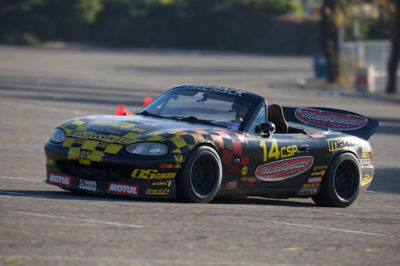The wonderful thing about SCCA Solo competition, also known as autocross, is you can go have fun with any car – no special preparation or safety equipment, other than a helmet and working seat belts, necessary. Of course, if you start with a Mazda MX-5 Miata, you’re probably having more fun than a lot of people right off the bat.
While SCCA offers a class for just about everything in stock form, things get more fun when you can start preparing the car more for competition without the compromises that a street car must offer. While the Miata is fun, the features that Mazda must put in to make it safe and comfortable on the road ultimately add weight. If you can get rid of a bunch of weight, and stiffen up the handling – so much so that it’s no longer comfortable on the street – then you’ve got something. Go far enough, and you’ve built yourself a C Street Prepared car like Bill Schenker’s.
While the category is called Street Prepared, there’s really not any street left in a car that’s taken to the limit of the rules – no interior, racing seat, racing steering wheel, competition harnesses … all those things make it illegal and/or uncomfortable to drive on the street. So if you’re going to do it, be prepared to dedicate a car to autocross competition.
Building a C Street Prepared car can get expensive in a hurry. Ask Bill Schenker what it takes to build a CSP car like his, capable of winning National-level events and showing well at the Solo National Championships, and he replies, jokingly, “Be rich.” But when he gets serious, he says there are blueprints to follow that will get you to a competitive car without all the trial and error that he did along the way.
“Look at the Eckles car,” he says, referring to the ’94 Miata that Sue Eckles and John Hunter drove to the CSP Ladies and CSP National Championship in 2013. “They’ve got a junkyard VVT motor in it. They’ve done it on a budget to some degree and they’re super competitive. It’s not the money you throw at the car, it’s how you put it together. Suspension is everything. Shocks are the most important.”
Part of hitting the right setup is starting with quality shocks, springs and anti-sway bars. There’s no point in taking intermediary steps here, Schenker says – go straight for the good stuff. Then it comes down to the details.
“I see so many people whose ride heights are off. They’re too low on the front, too high on the back, things like that. It’s all those things that change the car around. Anthony [Porta, his co-driver for the San Diego Championship Tour event] has a Mazdaspeed, and he says my car just sticks more. I’ve got better shocks, but it’s also – with the help of others – got all the details of ride heights and camber. A lot of people make the mistake of putting more camber in the rear than the front. You want a lot of camber on the front and maybe 0.7 degrees less in the rear,” he says
Above all, don’t be afraid to ask questions. The autocross grid isn’t like Gasoline Alley at Indy – most people all are too happy to share what they’ve done. Every part that Schenker has put on, he lists on a sponsor’s Web site.
“See what the top guys are doing,” notes Schenker. “See what the Eckles car is like, see what the Tom Kubo car is like, see what I do. It’s a pretty simple formula, and if you go straight to that formula, you’ll save a lot of money.
And, of course, don’t forget to take advantage of the Mazdaspeed Motorsports Development Team Support Program and its corresponding parts discounts and contingencies. Those discounts can go a long way when building a new car for competition.


 ACCESSIBILITY
ACCESSIBILITY